Understanding Lung Arteriovenous Malformations
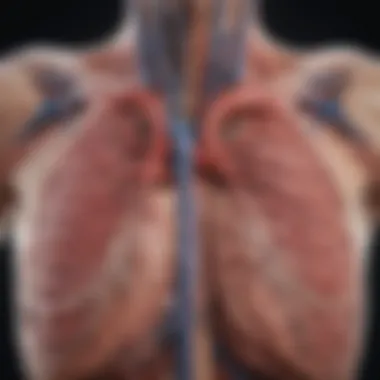
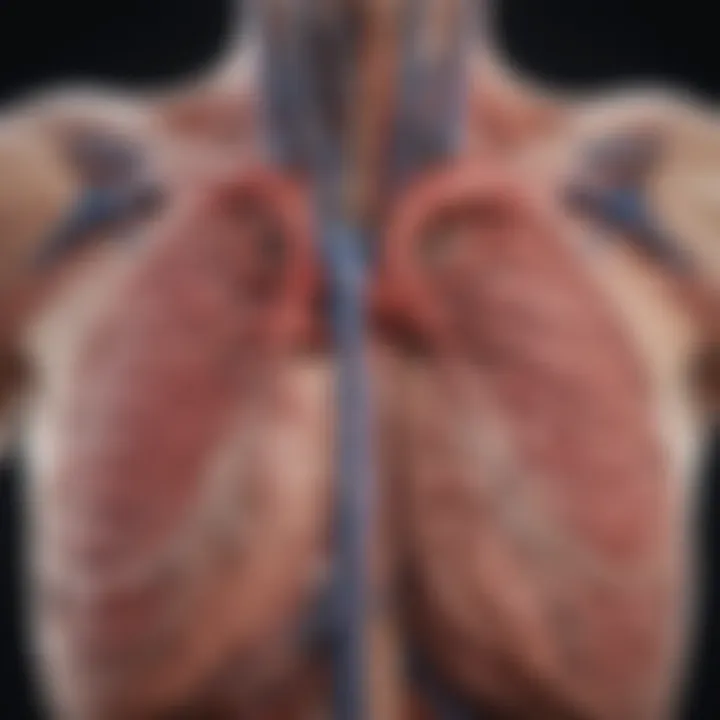
Intro
Lung arteriovenous malformations (AVMs) are abnormal connections between arteries and veins in the lungs. These anomalies can lead to various complications, making understanding their symptoms crucial. The complexity of lung AVMs manifests in a range of symptoms that can influence both diagnosis and treatment. The nuances of these symptoms often require careful analysis by healthcare professionals.
People with lung AVMs may present with diverse clinical features. Common symptoms include shortness of breath, fatigue, and even recurrent pneumonia. In some cases, patients might experience hemoptysis, which is coughing up blood. These symptoms can be subtle or severe, complicating the clinical picture.
To gain a comprehensive understanding of lung AVMs, it is essential to explore their causes, diagnostic methods, and management options. Early detection plays a vital role in improving health outcomes for affected individuals. An in-depth discussion about the implications of lung AVMs will benefit not just researchers and healthcare providers but also students and educators in related fields.
This article aims to elucidate the intricate aspects of lung arteriovenous malformations while highlighting their clinical significance.
Preamble to Lung Arteriovenous Malformations
Lung arteriovenous malformations (AVMs) are intricate vascular anomalies that can have significant implications for patient health. Understanding these anomalies is crucial for healthcare professionals, researchers, and students alike. Such knowledge directly impacts the early detection and management of potential complications arising from lung AVMs.
The importance of this introduction lies in its role as a foundation for comprehending the various aspects related to lung AVMs. These conditions can affect blood flow and oxygenation within the lungs, leading to a range of symptoms and health risks. The complexities of lung AVMs demand a thorough understanding of their characteristics, the biological mechanisms behind them, and how to recognize their symptoms effectively.
Key Elements to Consider:
- Clinical Significance: It is essential to appreciate how lung AVMs can mask underlying medical issues or lead to misdiagnosis if their symptoms are not well understood.
- Impact on Quality of Life: Patients with lung AVMs might experience chronic symptoms that hinder their daily activities, thus affecting their well-being.
- Research Developments: Continuous exploration in the field of vascular anomalies allows for the identification of novel diagnostic and treatment methods, enhancing overall healthcare outcomes.
By delving further into the topic of lung AVMs, one can better grasp the symptoms, their implications, and the critical nature of timely diagnosis. Education and awareness can pave the way for improved healthcare strategies that cater to those affected by this condition.
"An informed approach towards lung arteriovenous malformations can lead to better patient outcomes and reduce the risk of severe complications."
Ultimately, this introduction sets the stage for a more comprehensive exploration of lung AVMs, making it a crucial part of any educational or professional discourse on the subject.
Defining Lung AVMs
Lung arteriovenous malformations (AVMs) are abnormal connections between the pulmonary arteries and veins. These connections disrupt normal blood flow in the lungs and can lead to various complications. Understanding what lung AVMs are is crucial for accurate diagnosis and effective management. The significance of defining lung AVMs lies in several key areas.
Firstly, by accurately defining lung AVMs, we clarify their physiological and anatomical implications. These malformations may occur congenitally or as a result of other conditions. A clear definition helps professionals distinguish between normal vascular structures and pathological anomalies.
Given their complexity, lung AVMs can complicate the assessment of lung function and overall health.
Moreover, defining these malformations aids in understanding their potential symptoms. The connections cause an abnormal shunting of blood, which can lead to consequences like hypoxia or pulmonary hypertension. For instance, a clearer definition allows medical practitioners to anticipate the symptoms a patient may experience, leading to timely interventions.
In clinical practice, recognition and definition of lung AVMs contribute to associated risks. These include the potential for hemorrhage or the development of additional vascular anomalies. Understanding the characteristics of AVMs allows for more informed discussions regarding patient education and management plans.
"Properly defining lung arteriovenous malformations is the first step toward effective patient care and management."
Finally, educational initiatives targeting students and healthcare professionals benefit immensely from clear definitions. Understanding lung AVMs can increase awareness and foster collaborative efforts in research for better treatment modalities.
In essence, defining lung AVMs is not merely academic. It serves as a foundation for diagnosis, management, and education in a field that directly impacts patient outcomes. The complexity of these vascular anomalies necessitates a thorough understanding of their nature and implications.
Anatomy of the Lungs and Vascular System
The anatomy of the lungs and the vascular system plays a critical role in understanding lung arteriovenous malformations (AVMs). A nuanced comprehension of these structures is essential to appreciate how lung AVMs manifest and affect overall health.
The lungs are primarily composed of a series of airways, alveoli, and blood vessels, allowing for the exchange of oxygen and carbon dioxide. This intricate network is supported by the pulmonary circulation, responsible for transporting blood from the heart to the lungs and back again. The pulmonary arteries carry deoxygenated blood from the right side of the heart to the lungs, where it undergoes oxygenation. Once this process occurs, oxygen-rich blood returns to the left side of the heart via the pulmonary veins, ready to be distributed throughout the body.
Understanding these basic functions helps in recognizing how AVMs disrupt normal pulmonary circulation. In an AVM, abnormal connections between arteries and veins bypass the capillary system, where blood typically becomes oxygenated. Consequently, this can lead to various complications, including hypoxemia, where the blood lacks sufficient oxygen.
Key Considerations:
- Pulmonary Vasculature: Familiarity with the vascular structures is vital since AVMs often distort normal blood flow. Such changes may precipitate symptoms like fatigue or shortness of breath.
- Lung Segmentation: The lungs have distinct lobes, with their own blood supply. AVMs can occur in specific lobes, leading to localized symptoms and requiring targeted intervention.
- Interdependence: The relationship between lung anatomy and the vascular system is interdependent. Anomalies in one can cause repercussions in the other, emphasizing the need to analyze both structures holistically.
The importance of understanding the anatomy extends beyond mere structure. It facilitates healthcare professionals in diagnosing and managing lung AVMs effectively. Knowledge of arterial and venous flow can guide imaging and treatment decisions, potentially improving patient outcomes.
"Understanding the anatomy of the lungs and vascular system is fundamental to grasping how arteriovenous malformations disrupt critical physiological processes."
In summary, the anatomy of the lungs and the vascular system is a cornerstone of any discussion on lung AVMs. A comprehensive understanding equips medical practitioners with the insight needed for effective diagnosis and management, underscoring its importance in the broader context of lung health.
Common Symptoms of Lung AVMs
Understanding the common symptoms associated with lung arteriovenous malformations (AVMs) is critical. Symptoms can influence both diagnosis and the management of AVMs. This section gives insights into how these symptoms affect patients and their overall health. Recognizing these symptoms early can lead to timely interventions, potentially reducing the risk of serious complications.
Hemoptysis
Hemoptysis refers to the coughing up of blood from the respiratory tract. This symptom is particularly concerning and warrants immediate medical attention. In the context of lung AVMs, hemoptysis occurs due to the abnormal blood flow and pressure within the vessels connected to the lungs. It can vary in severity, ranging from small streaks of blood to copious amounts, which can indicate a more severe underlying issue. Immediate evaluation is important to ascertain the cause and potential risks involved with this symptom.
Shortness of Breath


Shortness of breath, or dyspnea, often accompanies lung AVMs. Patients might find it difficult to breathe with exertion or even while at rest. This symptom may result from several factors, including increased blood flow shunting, reduced oxygenation due to abnormal vessel connections, or increased pulmonary pressure. It emphasizes the need for a comprehensive evaluation to understand the underlying causes and to formulate an effective treatment plan.
Recurrent Respiratory Infections
The potential for recurrent respiratory infections, such as pneumonia or bronchitis, is another symptom noted in individuals with lung AVMs. The malformations can create an environment for bacteria to thrive due to altered blood flow and airway obstruction. These infections can further complicate the clinical picture, as they may require antibiotic interventions and can lead to long-term health issues if not properly managed. Awareness of this symptom allows for prompt action to prevent exacerbations.
Fatigue
Fatigue is a less specific but impactful symptom that patients with lung AVMs may experience. This can result from chronic hypoxemia, which is a lower-than-normal level of oxygen in the blood. Coupled with other symptoms, fatigue often affects the quality of life. Understanding the interplay between fatigue and lung AVMs is necessary for comprehensive patient care. It calls for a multimodal approach to management, focusing on both physical and psychological aspects of health.
Rare Symptoms Associated with Lung AVMs
Understanding the rare symptoms associated with lung arteriovenous malformations (AVMs) is critical for multiple reasons. First, while many patients exhibit common symptoms, the rarer manifestations could indicate severe complications. These symptoms add complexity to the clinical picture, often requiring a more nuanced approach to diagnosis and management. Recognizing these rare symptoms ensures early intervention, improving patient outcomes and preventing progression to severe conditions.
Cyanosis
Cyanosis is a condition characterized by a bluish discoloration of the skin and mucous membranes, usually indicating an inadequate supply of oxygen. In the context of lung AVMs, cyanosis occurs when high-flow AVMs divert oxygenated blood away from the lungs, allowing deoxygenated blood to enter systemic circulation. This can lead to systemic hypoxemia, which poses significant health risks.
Patients with cyanosis often exhibit other symptoms such as pallor, fatigue, and reduced exercise tolerance. Cyanotic episodes can be triggered by physical exertion or respiratory distress. It is essential for healthcare professionals to be vigilant for cyanosis when evaluating patients suspected of having lung AVMs. Recognizing this symptom can drive swift diagnostic imaging, where techniques like CT angiography may help visualize the abnormal vascular connections.
Pulmonary Hypertension
Pulmonary hypertension is another rare but serious symptom associated with lung AVMs. It is characterized by elevated blood pressure in the pulmonary arteries, leading to heart strain and reduced oxygen delivery. The presence of AVMs can create a shunt directing blood away from the lungs, causing the remaining vessels to work harder to circulate blood.
Symptoms of pulmonary hypertension include shortness of breath, chest pain, and palpitations. These symptoms do not always point directly to AVMs, which can complicate diagnosis. Initial assessments may reveal normal lung function, further delaying recognition of the underlying condition. If pulmonary hypertension progresses, it can lead to right-side heart failure and other severe complications.
Managing pulmonary hypertension often involves a multidisciplinary approach. This may include medication to lower blood pressure in pulmonary arteries and interventions to address the underlying AVMs, such as embolization. Awareness of this rare symptom is crucial for early identification and treatment.
Being aware of rare symptoms linked to lung AVMs can lead to timely diagnosis and better management strategies, potentially saving lives.
Potential Causes of Lung AVMs
Understanding the potential causes of lung arteriovenous malformations (AVMs) is crucial for medical professionals and anyone interested in vascular anomalies. Identifying the origin of these conditions allows for better diagnosis, management, and patient education. Moreover, exploring the causes can shed light on preventive measures and highlight important considerations for those affected.
Genetic Factors
Genetic factors play a significant role in the formation of lung AVMs. These malformations can occur as isolated events, but they are often linked to underlying genetic syndromes. For instance, conditions such as Hereditary Hemorrhagic Telangiectasia (HHT) are known to increase the risk of developing AVMs. Genetic mutations that affect vascular development can lead to abnormal connections between arteries and veins in the lungs.
Research indicates that mutations in the ENG and ACVRL1 genes are commonly associated with HHT. Understanding these genetic underpinnings can lead to early detection not only for patients, but also for their relatives, who may share the same genetic predisposition. Genetic counseling may also be beneficial, providing insights into risks and family planning.
Acquired Conditions
Acquired conditions can also contribute to the development of lung AVMs. Certain diseases or environmental factors may alter the normal structure of blood vessels, leading to the formation of these vascular anomalies. Conditions such as pulmonary hypertension and liver cirrhosis are observed to have correlations with AVM development.
In cases of pulmonary hypertension, the increased pressure can stress the vascular system, potentially causing structural changes that result in AVMs. Liver cirrhosis, on the other hand, affects blood flow dynamics and can lead to the formation of abnormal connections between arteries and veins. Certain infectious diseases, including histoplasmosis or tuberculosis, may also contribute to AVM formation through lung tissue damage or scarring, which can disrupt normal vascular architecture.
Diagnosis of Lung AVMs
Diagnosing lung arteriovenous malformations (AVMs) is a crucial process that significantly impacts the management and treatment of these conditions. Effective diagnosis can ensure early identification, which is vital in preventing potential complications. Understanding both imaging techniques and clinical evaluations is essential in forming a comprehensive diagnostic strategy. A combination of these approaches provides a clear picture of the patient’s vascular status and informs decision-making for subsequent management.
Imaging Techniques
CT Angiography
CT Angiography is a key imaging method used in diagnosing lung AVMs. It offers detailed cross-sectional images of blood vessels and surrounding tissues, which can reveal the presence and anatomy of AVMs. A primary characteristic of CT Angiography is its ability to visualize vascular structures with high resolution. This makes it a beneficial choice because it can provide direct images of the malformations. The unique feature of CT Angiography lies in its rapid acquisition of images and the ability to use contrast agents, enhancing the clarity of vascular mapping. However, a potential disadvantage includes exposure to ionizing radiation, which must be considered when determining the frequency of its use in evaluation.
Chest X-Ray
Chest X-Ray is another basic imaging tool utilized in the initial assessment of lung AVMs. Its key characteristic is the accessibility and speed of obtaining images. Often, it serves as the first step before more advanced imaging techniques are employed. The unique feature of Chest X-Ray is its capability to detect indirect signs of AVMs such as increased vascular markings or signs of heart enlargement. However, its limitations include lower sensitivity and detail compared to CT Angiography, meaning it might not always detect smaller or less prominent malformations.
MRI
MRI is increasingly recognized for its role in the evaluation of lung AVMs. Its specific aspect is the ability to produce detailed images without the use of ionizing radiation, which is a significant advantage. The key characteristic of MRI is its proficiency in soft tissue contrast, making it useful for assessing adjacent structures and identifying possible complications. The unique feature of MRI is its capability to provide functional information about blood flow, enhancing the understanding of abnormalities in the vascular system. However, it is often less available compared to CT and can be time-consuming for patients, which might limit its practical use in urgent cases.
Clinical Evaluations
Clinical evaluations supplement imaging techniques to ensure that lung AVMs are accurately diagnosed. They involve gathering detailed patient information, which is vital for forming a proper diagnosis. The process allows healthcare professionals to take a holistic approach to patient health, considering both the clinical and imaging perspectives.
Medical History Review
Medical History Review is a critical component of the clinical evaluation process. It involves a comprehensive assessment of patient records and symptoms which could indicate the presence of lung AVMs. The main characteristic of this review is its ability to identify patterns of symptoms and predisposition to vascular conditions. It is beneficial because it provides context that imaging techniques alone may miss. The unique feature of Medical History Review lies in its role in establishing familial patterns or previous medical issues, which can guide further testing. However, relying solely on medical history can sometimes lead to oversight of silent presentations.
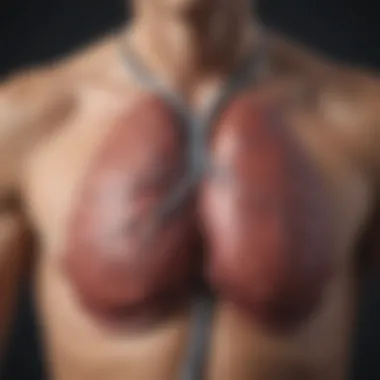

Physical Examination
Physical Examination plays a crucial role in confirming suspicions raised during the medical history review. It includes checking for signs of hypoxia, cyanosis, or abnormal lung sounds, which may be indicative of complications related to lung AVMs. Its key characteristic is the immediate feedback it provides regarding a patient’s acute state. Physical examination is beneficial in offering real-time observations that aid in expedient decision-making. The unique aspect is its ability to reveal urgent conditions that may not be evident through imaging alone. However, its limitations include a dependency on the practitioner's experience and sometimes subjective interpretations.
Management Strategies for Lung AVMs
Management of lung arteriovenous malformations (AVMs) is crucial for improving patient outcomes. Given the complexity of this condition, effective management strategies can mitigate symptoms and prevent complications. The choice of management depends on factors such as the size and location of the AVM, patient symptoms, and overall health status. Early intervention can enhance prognosis and quality of life for patients. Ultimately, understanding these strategies is essential for healthcare providers and patients alike.
Surgical Interventions
Surgical intervention plays a pivotal role in managing lung AVMs. There are two main types of surgical procedures that are often considered: surgical resection and embolization procedures.
Surgical Resection
Surgical resection involves the removal of the affected portion of the lung or the AVM itself. This approach can provide immediate relief from symptoms and prevent potential complications such as hemorrhage.
One key characteristic of surgical resection is its ability to directly eliminate the source of symptoms. As a result, patients often experience significant improvements in their overall health after this surgery.
However, surgical resection may not always be feasible. The procedure's success can be impacted by the location of the AVM and the patient's pulmonary function. Complications can include pain, infection, and longer recovery times.
This type of intervention is often considered when the AVM is significant enough to warrant surgical action. Therefore, it is a beneficial option in many cases.
Embolization Procedures
Embolization procedures involve the use of materials to block the blood vessels leading to the AVM. This minimally invasive technique is increasingly popular due to its reduced recovery time and lower risk compared to traditional surgery.
A key characteristic of embolization is its ability to selectively target the malformation without removing lung tissue. This approach preserves lung function, making it an attractive option for patients with surgical risks or those who have multiple AVMs.
However, embolization has its potential drawbacks. There can be risks of complications such as migration of embolic agents or incomplete occlusion of the AVM, leading to the need for additional interventions. Despite these risks, this procedure remains a valuable management strategy for lung AVMs.
Radiological Approaches
Radiological approaches are essential for diagnosing, monitoring, and managing lung AVMs. Imaging studies guide decision-making regarding treatment options and assess the effectiveness of ongoing therapies.
Benefits and Risks of Embolization
The benefits of embolization are numerous. This technique can minimize the size of the AVM and alleviate symptoms effectively. Moreover, because it is performed through a catheter, recovery is generally quicker, and patients can return to their normal activities sooner.
Despite these advantages, embolization also comes with risks. Potential complications include infection, damage to surrounding tissues, and the chance of needing further procedures if the AVM does not close completely.
Ultimately, the decision to proceed with embolization involves careful consideration of these benefits and risks, tailored to each patient's unique circumstances.
Managing lung AVMs requires an understanding of various treatment options, addressing both immediate needs and long-term implications.
Prognosis and Long-term Care
The prognosis for patients with lung arteriovenous malformations (AVMs) can vary significantly depending on several factors, including the size, location, and number of AVMs present. Understanding the long-term care involved becomes crucial for managing this condition effectively. A well-structured long-term care plan can improve patient outcomes and minimize complications.
Importance of Prognosis
Prognosis in the context of lung AVMs is essential for several reasons. It helps patients and healthcare providers to understand what to expect regarding disease progression and potential complications. With accurate prognostic knowledge, patients can make informed decisions about their treatment options and lifestyle adjustments. Moreover, healthcare providers can tailor their management strategies and anticipate challenges that may arise in the future.
Long-term Care Considerations
Long-term care of lung AVM patients may include regular monitoring through various imaging techniques to watch for changes in the malformations. Follow-up appointments are vital to evaluate symptoms and overall lung function. This allows for adjustments in management strategies as needed.
It's also important to manage comorbid conditions that may arise or exacerbate the effects of lung AVMs. Patients may be at risk for conditions like pulmonary hypertension or recurrent respiratory infections. Addressing these issues through a comprehensive care plan can significantly improve quality of life.
Benefits of Early Intervention
Intervening early in the course of the condition can lead to better outcomes. Patients diagnosed with lung AVMs may benefit from surgical procedures, such as embolization or resection, which can alleviate symptoms and reduce risks of hemorrhage.
"Early detection and intervention are important for improving the prognosis of lung AVM patients, potentially preventing serious complications."
Continuous Patient Education
Ongoing patient education is a key component of long-term care. Patients must be informed about symptom recognition and when to seek help. This fosters a proactive approach to managing their health and promotes adherence to follow-up schedules.
Multidisciplinary Approach
Employing a multidisciplinary approach involving pulmonologists, vascular surgeons, and other specialists can enhance care quality. Such collaboration ensures that all aspects of a patient’s health are addressed. Emotional support, often overlooked, should not be neglected. Patient support groups can offer resources and emotional solace for those dealing with the implications of lung AVMs.
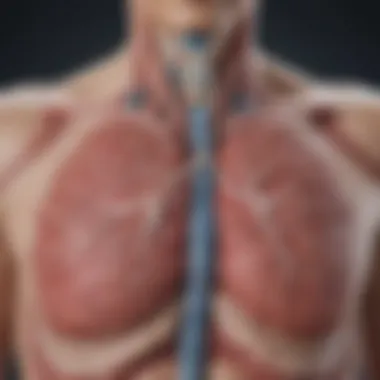
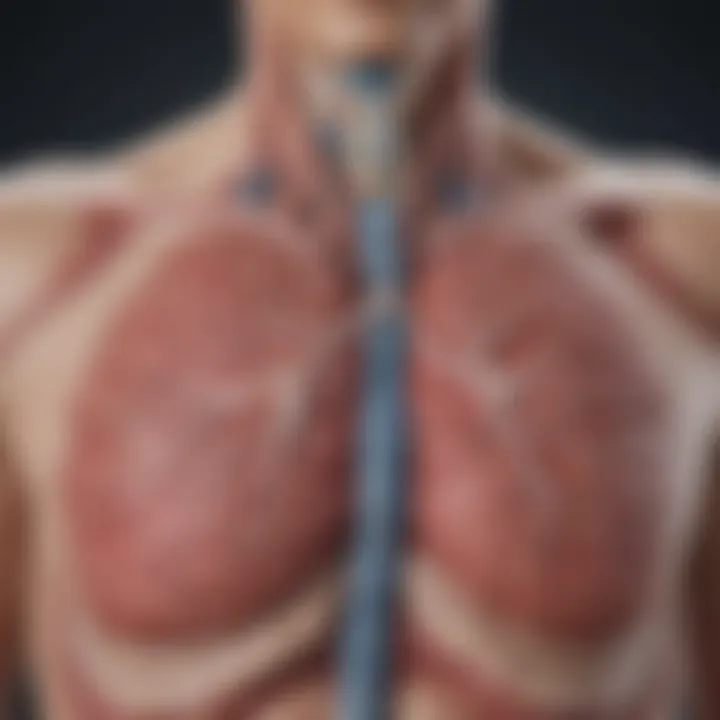
Complications Associated with Lung AVMs
Lung arteriovenous malformations (AVMs) pose significant risks that necessitate careful consideration. Understanding these complications is crucial for both healthcare professionals and patients. Early detection and appropriate management can significantly affect patient outcomes, thus emphasizing the importance of awareness regarding possible complications.
Complications of lung AVMs can be serious. They include a heightened risk of severe hemorrhage and the potential for developing other vascular anomalies. A detailed understanding of these risks helps in devising effective management strategies for these patients.
Potential for Severe Hemorrhage
One of the most alarming complications of lung AVMs is the potential for severe hemorrhage. This can occur when an AVM ruptures, leading to significant blood loss and immediate health threats. The blood vessels in these malformations can become fragile, making them susceptible to rupture.
Patients may experience acute hemoptysis, which is coughing up blood. This symptom demands immediate medical attention. The volume of blood loss can also lead to hypovolemic shock, a life-threatening condition requiring urgent intervention.
To mitigate this risk, regular monitoring and preventive strategies are vital. Surgical procedures, such as embolization, are often utilized to manage the AVM and reduce the risk of rupture. Additionally, patient education plays a key role in recognizing early signs of complications, ensuring timely medical response.
Development of Other Vascular Anomalies
Lung AVMs can also pave the way for other vascular anomalies. When AVMs occur, they can alter normal blood flow dynamics, which may lead to subsequent abnormalities in vascular structure or function. This includes the formation of other types of abnormal blood vessels or even the development of more extensive vascular malformations.
These conditions can further complicate the clinical picture and require comprehensive care approaches. Diagnosis often involves imaging techniques that can help visualize the vascular system. Healthcare providers must remain vigilant in monitoring for these complications, as they can impede treatment progress.
Patient Awareness and Education
Patient awareness and education about lung arteriovenous malformations (AVMs) play a vital role in their identification and management. Understanding the nature of these malformations, how they manifest, and the implications they may carry can significantly influence patient outcomes. Increased awareness not only empowers patients but also enables healthcare providers to offer tailored interventions promptly.
One critical aspect of patient education is the recognition of symptoms associated with lung AVMs. Patients who are knowledgeable about the warning signs, such as hemoptysis or shortness of breath, are more likely to seek medical attention promptly. This proactive approach can be instrumental in minimizing complications. Early detection leads to better management strategies, which can limit the progression of the disease and enhance quality of life.
Patients should also be made aware of the potential complications associated with lung AVMs. Understanding risks such as severe hemorrhage or the development of other vascular anomalies can foster a more serious approach to symptoms, leading to timely consultations with healthcare professionals.
"Education is paramount in navigating healthcare challenges. Recognizing symptoms and knowing when to seek help can save lives."
Additionally, a well-informed patient is more likely to engage in discussions with their medical team. They will ask informed questions which can lead to better healthcare decisions. This level of engagement can foster a collaborative relationship between patients and providers, cultivating trust and adherence to treatment plans. Without adequate education on lung AVMs, patients may feel marginalized, which could result in a lack of necessary medical interventions.
Importance of Symptom Recognition
The recognition of symptoms related to lung AVMs is crucial. Symptoms like fatigue, recurrent respiratory infections, or cyanosis should not be dismissed. It is a common scenario where patients attribute such symptoms to common illnesses, which may lead to delayed diagnosis. This situation prolongs potential complications and risks associated with untreated lung AVMs.
Patients and their families should be educated about these symptoms, and healthcare providers should conduct regular assessments. Keeping a symptom diary can also be beneficial for patients, helping them maintain a record of their health status to provide detailed information during consultations.
Role of Support Groups
Support groups serve as an essential resource for individuals affected by lung AVMs. These groups can foster a sense of community, allowing patients to share experiences, challenges, and coping strategies. Engaging with others facing similar issues can alleviate feelings of isolation and provide emotional support.
Support groups also provide valuable educational opportunities. They often host guest speakers or informational sessions regarding advancements in treatment options, nutrition, and lifestyle changes beneficial for managing lung AVMs. Access to accurate information from experienced individuals can enhance the coping mechanisms of patients or caregivers.
Moreover, these groups can advocate for increased awareness and research funding, contributing to improved treatment modalities and support systems. The collective voice of support groups has the potential to influence public health policy, making them an invaluable component in the journey of managing lung AVMs.
Current Research and Future Directions
Understanding lung arteriovenous malformations entails more than just grasping their existing symptoms and management. Current research plays a pivotal role in shaping future strategies for treatment, diagnosis, and overall patient care. Recent advancements have opened new avenues, providing crucial insights that could significantly enhance health outcomes for patients suffering from lung AVMs. Improved comprehension of these conditions leads to tailored therapies, minimizes complications, and advances the collective knowledge within the medical community.
Advancements in Treatment Modalities
Recent years have seen promising developments in treatment options for lung AVMs. Traditionally, surgical resection was the mainstay for managing symptomatic cases. However, innovative approaches have taken precedence, particularly because of their less invasive nature. Among these methods, embolization procedures have gained considerable attention.
Embolization, which involves inserting materials to block abnormal blood vessels, has proven effective in controlling symptoms such as hemoptysis and preventing complications like severe hemorrhage. Studies show that the procedure can lead to significant improvements in quality of life for patients, making it a viable alternative to surgery. Furthermore, minimally invasive techniques have reduced recovery times, allowing patients to resume normal activities sooner.
Some researchers are exploring pharmacological agents designed to stabilize vascular anomalies. This class of medications may potentially prevent the formation or enlargement of AVMs. Future clinical trials will likely expand on these findings, testing the effectiveness and safety of various pharmacotherapies.
Ongoing Clinical Trials
Clinical trials are essential for addressing gaps in knowledge surrounding lung AVMs. Currently, various clinical trials are underway exploring novel treatment modalities, patient response to therapies, and the long-term effects of interventions. These trials focus on multiple aspects:
- Evaluating the effectiveness of newer embolization materials and techniques.
- Assessing patient outcomes post-surgery versus non-surgical interventions.
- Understanding the genetic factors contributing to AVM development and recurrence.
"Engagement in clinical trials not only provides access to cutting-edge treatments but also contributes to the evolution of our understanding of vascular anomalies."
Participating in these studies often enables patients to gain access to innovations before they are widely available. They also play a crucial role in gathering data that will form the foundation for future guidelines and treatment protocols. As researchers continue to uncover the complexities of lung AVMs, patients and healthcare providers alike will benefit from these advances.
The exploration of current research and ongoing trials signifies a strong commitment to improving the lives of individuals with lung arteriovenous malformations. By laying the groundwork for future discoveries, the medical community can better address the intricate challenges posed by these vascular anomalies.
Epilogue
The conclusion serves as a critical reflection on the information we've explored regarding lung arteriovenous malformations (AVMs). Understanding the symptoms and implications associated with lung AVMs is essential for both patients and healthcare providers. This article reinforces the intricate relationships between clinical presentation, diagnosis, and management of these vascular anomalies.
A key element discussed is the variability of symptoms, ranging from common indicators like hemoptysis to rare manifestations such as cyanosis. This variability emphasizes the need for both awareness and a systematic approach to diagnosis. Early detection can significantly alter the course of treatment. Appropriate management can lead to better health outcomes, reducing the risks of complications such as severe hemorrhage or pulmonary hypertension.
Moreover, the article highlights the importance of patient education and awareness. Patients who recognize symptoms early can seek medical advice promptly, which is crucial for effective management. Support groups can offer both emotional and practical support, fostering a community that can navigate the challenges of living with lung AVMs.



